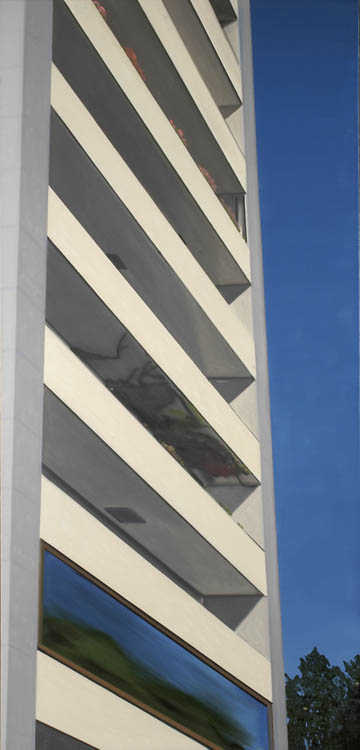Especially in the 2000s he numbered among the most important protagonists of young German painting. Born in 1967, Eberhard Havekost studied in the 1990s at Dresden Academy of Fine Arts. The first few years of the new millennium saw the rise of the “New Leipzig School”, whose members included Neo Rauch, Tim Eitel, Matthias Weischer and many other artists besides. But Havekost never felt part of this group. Later less was heard of the artist, who today lives and works in Berlin.
If you were to choose a key term for Eberhard Havekost’s painting it would be “user interface”. This was the title Havekost gave to a painting in 1999, which has been part of the Städel Museum collection since 2007. His paintings offer observers several points of access, references yes, but which are never all that clear. Havekost paints (almost) everything: people, automobiles; buildings feature frequently. The motifs are often edited on a computer, distorted, shown in extreme perspectives or as cropped sections.
Color-field painting
Often Havekost creates several variations of a single motif, varying perspective and cropping the image, whether the subject is balconies of (late) modern housing estates, like those depicted on the painting in the Städel collection, or caravans and tents, provisional accommodation, which could be said to stand for our present-day longing for flexibility. Havekost all but transforms the windows of a double-deck regional train into a color-field painting.

Eberhard Havekost, Benutzeroberfläche 1, 1999. Städel Museum, Frankfurt am Main. Photo: Rühl & Bormann. © Eberhard Havekost, courtesy of Galerie Gebr. Lehmann, Berlin/Dresden, Image via db-artmag.de
The images frequently slip into the abstract, the motif dissolves into fields and structures. Yet Havekost’s painting style is representational and clear. He often smudges individual sections with the brush. Consequently, his paintings alternate between blurring and geometric austerity. Their style is sometimes reminiscent of Luc Tuyman or Gerhard Richter. Yet Havekost’s motifs have a quotidian reference and are contemporary.
Entry into digitalization
Eberhard Havekost almost always paints from photos and distances himself from the expectation of an original, brilliant idea for a picture. Admittedly, Gerhard Richter has done the same, but what is new with Havekost is that he works from digital images. They are photographs and images that can be seen on screens, and do not exist as paper printouts. While in Richter's work the specific material appearance of the print plays a role, Havekost’s approach marks the entry into the digitalization of imagery, which has progressed at breakneck speed in recent years.

Eberhard Havekost, exhibition view "Retina" at SCHIRN 2010, photo: Norbert Miguletz
Social networks like Instagram only function at a visual level; every day hundreds of thousands of new photographs are posted. Retrospectively, you can see Havekost with his radical love of the visual as a pioneer of today’s fast image culture. But his paintings are not self-presentations and do not depict embellished private scenarios. Rather there is a feeling of coldness and alienation to Havekost’s images. Sometimes they tell of crime and destruction. If Havekost’s paintings had a sound it would be electronic, cool, industrial.
A naked foot on the lower edge of the picture
In 2009 Eberhard Havekost experimented with fuzzy subjects abstracted almost beyond recognition, blurry motifs which made his painting “more painterly” and emphasized the impact of the color. Works from this phase of his output could be viewed in 2010 in Havekost’s solo show “Retina” at the SCHIRN.

In the current exhibition “ME” visitors can view two inkjet photo prints by Eberhard Havekost that capture a fragment of the nomadic lifestyle of a successful artist. The two small-format pieces are called “Hotel” and were created in 2003. The photos concentrate on typical, neutral and anonymous hotel furnishings. In one a naked foot appears at the lower edge of the image, in the other we see part of a knee. The person depicted, who is portraying himself, can only be seen partially. The reference is as minimal as possible, but it suffices to suggest someone’s presence.